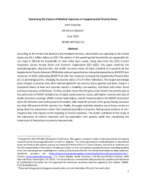
An official website of the United States government
Here’s how you know
Official websites use .gov
A .gov website belongs to an official government organization in the United States.
Secure .gov websites use HTTPS
A lock (
) or https:// means you’ve safely connected to the .gov website. Share sensitive information only on official, secure websites.
-
//
- Census.gov /
- Library /
- Census Working Papers /
- Examining the Impact of Medical Expenses on Supplemental Poverty Rates
Examining the Impact of Medical Expenses on Supplemental Poverty Rates
Examining the Impact of Medical Expenses on Supplemental Poverty Rates
According to the Centers for Medicare and Medicaid Services, total health care spending in the United States was $4.1 trillion dollars in 2020. The portion of this spending that households are responsible for can make it difficult for households to meet other basic needs. Using data from the 2021 Current Population Survey Annual Social and Economic Supplement (CPS ASEC), this paper examines the sociodemographic characteristics and health insurance status of those classified as in poverty by the Supplemental Poverty Measure (SPM) after subtracting medical out-of-pocket expenditures (MOOP) from resources.
In 2020, subtracting MOOP from after-tax resources increased the Supplemental Poverty Rate by 1.5 percentage points, changing the poverty status of 5.0 million individuals. The largest percentage point changes in poverty rates after subtracting MOOP are seen for those aged 65 and older, living in a household where at least one member reports a disability, non-workers, and those with either direct purchase insurance or Medicare. Further analysis shows that the group that moved into poverty due to the subtraction of MOOP tended to be of higher socio-economic status, with higher incomes and rates of health insurance coverage. While incomes were higher, overall resources before the MOOP subtraction were still relatively near to the poverty thresholds, with nearly 90 percent of this group having resources less than 200 percent of their poverty line. Finally, this paper examines whether any of these results are being driven by imputations rather than reported expenditure amounts, finding some evidence of non-response bias with regards to the reporting of medical expenses. The results contribute to the study of the interaction of medical expenses and the population near poverty while also considering the importance of imputation on poverty measurement.
Share
Related Information
WORKING PAPER
Health Insurance Working PapersWORKING PAPER
Supplemental Poverty Measure Working PapersSome content on this site is available in several different electronic formats. Some of the files may require a plug-in or additional software to view.
 Yes
Yes
 No
NoComments or suggestions?


Top

